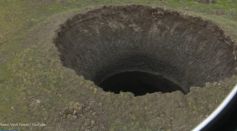Tags: Methane
Microbes of Deep-Sea Community Can Survive Extreme Heat, Influence Carbon Cycling

Oceanic Microbes Consume Methane 50 Times Faster, Regulating Earth's Temperature

Trapped in Time: The Ice Age Never Officially Ended in a Part of the Black Sea

Humans Cause Climate Change: NASA Show Direct Evidence from Calculation

Methane Emissions from Oil and Natural Gas Production Underestimated by the EPA
Cow Seaweed Diet Sees 86% Less Methane in Trials
Scientists Uncover the Mystery Behind the Massive Craters in Siberia

Submarines Could Explore Largest Sea on Saturn’s Moon Titan; Can You Guess How Deep Kraken Mare Is?
Researchers Developed a “Swiss Army Knife” Catalyst from 10 Different Elements
Researchers Report Progress on Greener, More Sustainable Hydrogen Extraction from Water

"Colossal Forces of Nature" Blast 165-ft Deep Hole in Russian Tundra
An Active Methane Seep in Antarctica May Help Explain Climate Change

Volatiles in Cold Traps , A Key to Understanding the Moon's Dark Craters
Enormous Methane Reservoir Discovered Under the Sea
New Cheap and Efficient Polymer for Natural Gas Adsorption, Synthesized by Researchers
Scientists Discover Frozen Methane Dunes on Pluto
Methane Spike On Mars Detected By Martian Rover
Emissions of Methane from Fertilizer Plants are 100 Times More Than Reported
New Satellites Pinpoint Greenhouse Emissions on Earth
Creation of New Molecules For New Formulas Results Into New Fuels & Medications
Most Popular

The Strongest Tornadoes Ever Recorded: Scientific Breakdown of Extreme Tornado Events

Can Scientists Predict Earthquakes? The Latest Advances in Seismic Forecasting Explained

How Space Affects the Human Body: Key Health Challenges Impacting the Astronauts

Photosynthesis Made Easy: Light Reactions, Calvin Cycle, and Everyday Examples





